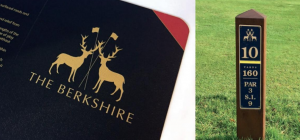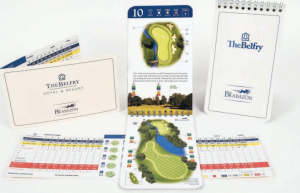Give your club a memorable IDENTITY
Having a clear brand, and the products to match, can enhance the experience of customers. We asked two leading companies why it makes such a difference…

 It may be the tired old sign that ‘welcomes’ people, or the uninspiring scorecard that holds the memory of a day’s play – some clubs are still stuck in the dark ages when it comes to establishing their brand. But having a clear identity and the products to match can add a lot of value to how visitors, and members, perceive your club and its offering. Get it right and the cash tills could be ringing a little more frequently. Whether it’s signage, yardage and green books or bag tags, it’s important to show your business in the best possible light. You would take action to repair faults on the course and in the clubhouse, so why would the message you send out to the community be any different? We asked two leading companies, Eagle and Clere Golf, why branding is so important.
It may be the tired old sign that ‘welcomes’ people, or the uninspiring scorecard that holds the memory of a day’s play – some clubs are still stuck in the dark ages when it comes to establishing their brand. But having a clear identity and the products to match can add a lot of value to how visitors, and members, perceive your club and its offering. Get it right and the cash tills could be ringing a little more frequently. Whether it’s signage, yardage and green books or bag tags, it’s important to show your business in the best possible light. You would take action to repair faults on the course and in the clubhouse, so why would the message you send out to the community be any different? We asked two leading companies, Eagle and Clere Golf, why branding is so important.
Phil McInley is managing director of Eagle, the UK’s leading golf course supplier,. They produce some 45 million scorecards each year and work with more than 1,750 clubs in 30 countries. Established in 1980, the company “take pride in helping golf clubs improve the impression they are creating through their signage, print collateral and online presence”.
If signage, architecture and accessories aren’t right, can the whole visitor experience be soured?
You’re absolutely right. Clubs can really differentiate themselves from the club down the road by improving the customer journey. From the entrance sign, through the driveway, the car park, and being directed from there to the changing rooms, pro shop, and out onto the first tee.
Some clubs don’t realise how important it is…
Why do you think that is?
It’s just an issue about understanding branding and positioning in the market place. For the first time, a lot of clubs have to market themselves.
This means that you have got to get the basic foundations in place. Design plays a big part in creating an identity that works – and this gives a structure, and a strategy, to get collateral products right. Signs, as well as print, fall into this category.
We like to offer value for money at the different levels. Whatever we manufacture will make a difference, and look good for a long time. We will ensure quality impressions on behalf of the club and this means using the right materials when manufacturing outdoor products.
What difference does a quality scorecard and products like that bring?
It’s all part of the visual journey of the visitors. It’s important for the member as well.
Every club has a golf community, which uses the club, and each scorecard is used for three to four hours and it creates impressions. They look at the signs. These are the things people do notice and the first thing they notice is the entrance sign when they are turning the car into the main road.
That’s why it’s so important that all these items are designed to a style – as these impressions help shape the image of the club.
So if I am a manager looking to change the image of my club, how can you help? What’s the process?
Firstly, we would advise as to how the club brand could be adjusted to work better.
We find that a lot of clubs don’t have the basic digital files in place, so they can’t actually produce a consistent product – whether it’s print or signage.
They don’t have the files in place, or a brand guidelines document, which gives a strategy for anybody buying anything on behalf of the club. What typeface? What support typeface? What colours they can use?
This is quite a basic thing that most start-up businesses would do as a priority, and then everything they buy, as part of their collateral, can start to tell a story about themselves.
Initially we would check their brand, maybe fine-tune it, maybe modernise it and produce a brand guidelines document.
From there, our design team can put together a whole collateral pack of products – scorecards, course guides, bag tag, green fee tickets. All of these things individually are just small items but together they become quite a powerful marketing tool.
How important is brand for golf clubs now?
Every business, and every club, has a brand but it is maximising the potential of that brand which is the key.
These days it’s pretty difficult to think of any activity involving two or three people that doesn’t have a namestyle, logotype, and an associated colour.
A lot of club brands do look rather dated. No professional designer has probably ever looked at the brand, and using scrolls and cross clubs can make it look quite dated. Most clubs are looking to attract new audiences and it is important they try and freshen up their brand so that it is more noticeable and stands out from other courses, so when they are creating a marketing campaign, they’ve got a design strategy ready to use. Branding, or identity management, has become a significant mainstream activity and is ignored at great peril.
Steve Richardson is a director at Clere Golf. With Gleneagles, Sunningdale and Celtic Manor among their clients, the company also produce the famous Green Books proving so popular in the professional game…
What does branding mean for Clere Golf?
Branding, for us, goes far beyond just a well designed logo which is really just a visual identifier, the brand is what the members or visitors think of when they see or hear it.
For instance, do they have positive thoughts when they see a particular club’s logo in a magazine or does it bring back negative thoughts about the greeting or service they received?
A club’s brand can be influenced by so many different touch points, such as staff, members, articles in trade publications and the quality of the course, which is why I believe presentation is so important across all items of media to re-enforce the thoughts members and visitors will have.
This is why an ever increasing number of the scorecards we develop nowadays carry lots of nice embellishments, from the rounded cornering that prevents snagging in the pocket to the addition of lamination for much greater durability when playing during inclement weather.
Why has this area been neglected by some clubs in a past?
It’s such a frustrating thing for us. In the past, I think the scorecard has always been deemed as a commodity-based item – very much price driven – but, actually, it is the first thing that every golfer, without doubt, picks up and, of course, the last thing they handle before they leave.
It’s important that the experience they (customers) get, even if it is only for a scorecard, portrays the club’s brand as best as it possibly can.
If the scorecard looks poorly designed and disintegrates throughout the round how does that reflect on the club?
I have to say that clubs are getting better educated about that and are beginning to take their scorecard, and all of their branding, a lot more seriously.
That’s where our heritage of creative design and experience of working with commercial brands can really add some value.
I suppose they aren’t just functional for everyone. They can also trigger memories of the day
For sure, they are so much more and you’ll see that now not just with scorecards but course guides too, which have so much more information in them than ever before.
Course guides have had to evolve in order to compete with Laser and GPS devices. I’m delighted to see a resurgence in them over the past 12 months with features in them taken from our tour course guides, such as tee photographs showing the golfer the direction to drive the ball from the tee with associated distances to carry hazards and find the centre of the fairway.
It’s simple really but, again, it adds value, enhances their experience and I’m sure will aid speed of play too.
Many scorecards carry advertisements or sponsors to help fund them and you are beginning to see things like pin location sheets incorporated onto the cards.
So I think they are becoming a much more important part of a golf club’s armoury.
The scorecard should be treated as an integral part of a golf club’s identity. Wherever the club logo is seen, whether it be in print, embroidered or on-line, there needs to be continuity of brand across anything that is produced. If you’ve got continuity, the strength of that brand is so much greater.
So what is the process if I am a manager and I’m thinking about calling you in?
Well this may differ depending on the product or service we are discussing with you but, on the whole, we wouldn’t want to be seen as just ’order processors’ as that’s not adding value.
We do that by offering good advice, asking intelligent questions, challenging the brief and suggesting options to consider based on past experiences.
We want to understand what isn’t currently working so that we can deliver something that either improves a process, enhances your club or adds value to the visitor/ member experience.
If we are able to do that then we are confident that we can build healthy long term relationships with our customers who will, in turn, refer us to other clubs. Simple.
We printed our first scorecard in 2006 and 12 years on we are proud to work with tremendous clubs, resorts and golf brands from around the world. Our success has been, and continues to be, based on the same core values on which we were founded almost 40 years ago. We strive to be approachable, collaborative and intelligent, working together to achieve common goals.
